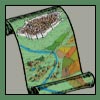Meditations
On the Second Sorrow - The Flight into Egypt.


(Taken from ‘The Glories of Mary’ by Saint Alphonsus Liguori)
As the stag, wounded by an arrow, carries the pain with him wherever he goes, because he carries with him the arrow that has wounded him; thus the Divine Mother, after the prophecy of St. Simeon, as we saw in our consideration of the first grief, always carried Her sorrow with Her by the continual remembrance of the passion of Her Son. Her continual thoughts of the passion of Jesus, kept always before Her eyes the blood which was one day to flow from His wounds.
Thy mind, oh Mary, and Thy thoughts tinged in the blood of the passion of our Lord, were always moved with sorrow as if they actually saw the blood flowing from His wounds. Thus Her Son Himself was that arrow in the Heart of Mary, who, the more worthy of love He showed Himself to Her, always wounded Her the more with the sorrowful thought that She should lose Him by so cruel a death.
Let us now pass to the consideration of the second sword of sorrow which wounded Mary, in the flight of Her infant Jesus into Egypt from the persecution of Herod. Herod having heard that the expected Messiah was born, foolishly feared that the new-born King would deprive him of his kingdom. Hence St. Fulgentius, reproving him for his folly, says: "Why, oh Herod, art Thou thus disturbed? This King who is born has not come to conquer kings by arms, but to subjugate them, in a wonderful manner, by His death."
The impious Herod, therefore, waited to learn from the holy magi where the King was born, that he might take from Him His life; but finding himself deceived by the magi, he ordered all the infants that could be found in the neighborhood of Bethlehem to be put to death. But an angel appeared in a dream to St. Joseph, and said to him: "Arise, and take the child and His Mother, and fly into Egypt." Immediately, on that very night, Joseph made this command known to Mary; and taking the infant Jesus, they commenced their journey, as we see clearly from the Gospel itself: "Who arose and took the child and His Mother by night, and retired into Egypt."
"Oh God," as Saint Albert the Great says in the name of Mary, "must He Who came to save men flee from men?" And then the afflicted Mary knew that already the prophecy of Simeon, regarding Her Son, was beginning to come true, seeing that scarcely is He born, when He is persecuted to death, "He is set for a sign which shall be contradicted." What suffering it must have been to the Heart of Mary, writes St. John Chrysostom, to hear the tidings of that cruel exile of Herself with Her Son! Flee from Thy friends to strangers, from the holy temple of the only true God, to the pagan temples of demons. What greater tribulation than that a new-born child, clinging to its Mother’s bosom, should be forced to fly with the Mother Herself!
Every one can imagine how much Mary must have suffered on this journey. It was a long distance to Egypt. Authors generally agree that it was four hundred miles; so that at least it was a journey of thirty days. The way, as St. Bonaventure describes it, was rough, unknown, through woods, and little frequented. The season was winter, and therefore they had to travel in snow, rain, wind, and storms, and through bad and difficult roads. Mary was then fifteen years of age, a delicate virgin, unaccustomed to such journeys.
Oh God, how piteous a spectacle it was to see that tender Virgin, with that newly born infant in Her arms wandering through this world! St. Bonaventure asks: " Where did they obtain food? Where did they rest at night? How were they lodged? What other food could they have, than a piece of hard bread which Joseph brought with him or food begged in charity? Where could they have slept (particularly in the two hundred miles of desert through which they traveled, where, as authors relate, there were neither houses nor inns) except on the sand, or under some tree in the wood, in the open air, exposed to robbers, or those wild beasts with which Egypt abounded?"
Ah, if any one had met then, these three greatest persons of the world, what would he have believed them to be except three poor roving beggars? They lived in Egypt, and here let us consider the great poverty they must have suffered for the seven years they were there, as St. Antoninus, St. Thomas, and others assert, they were foreigners, unknown, without income, without money, without family or friends; hardly were they able to support themselves by their humble labors.
As they were destitute, says St. Basil, it is obvious what effort they must have made to obtain the necessities of life. Moreover, Landolph of Saxony has written (and let it be repeated for the consolation of the poor) that so great was the poverty of the Holy Family that sometimes Mary had not so much as a morsel of bread, when Her Son, forced by hunger, asked it of Her.
It also teaches us to embrace crosses, for we cannot live in this world without a cross. The blessed Veronica da Binasco, an Augustinian nun, was carried in spirit to accompany the Holy Family in this journey to Egypt, and at the end of it the Divine Mother said to her: "Child, hast thou seen through what difficulties we have reached this place? Now learn that no one receives graces without suffering."
He who wishes to feel the sufferings of this life the least, must take Jesus and Mary with Him. For him who lovingly bears in his heart this Son and this Mother, all sufferings become light, and even sweet and dear. Let us then love Them, let us console Mary by receiving Her Son within our hearts, Whom, even now, men continue to persecute with their sins and torment by their indifference and ingratitude.
Then, Oh Mary, even after Thy Son hath died by the hands of men who persecuted Him unto death, have not these ungrateful men yet ceased from persecuting Him with their sins, and continuing to afflict Thee, oh Mother of Sorrows? And I also have been one of these. Ah, my most sweet Mother, obtain for me tears to weep for such ingratitude. And then, by the sufferings Thou didst experience in the journey to Egypt, assist me in the journey that I am making to eternity, that at length I may go to unite with Thee in loving my persecuted Savior, in the eternal country of the Blessed. Amen.
The sight, then, of Jesus, Mary and Joseph wandering like fugitives through this world, teaches us that we should also live as pilgrims on the earth.




